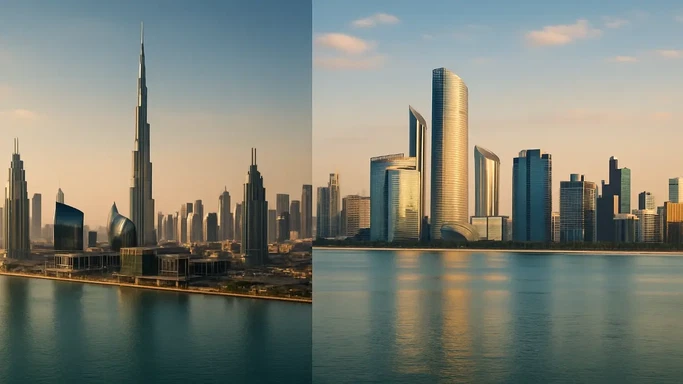Before entering into the lucrative micro-markets of the UAE’s top cities, astute investors primarily compare two emirates, Dubai & Abu Dhabi, for the best return on investments. From product mixes that shape rental yields to capital appreciation, both markets excel in providing regulatory backdrops and demand drivers.
Abu Dhabi is witnessing a solid prominence for sovereign-backed projects and thoughtful supply delivery, while Dubai has gained global status for surging transaction volumes and price growth. This guide compares capital growth, rental yield potential, and regulatory mechanisms so you can make the right move by choosing the right emirates for profitable buy-to-let outcomes.
Market Overviews: Analyzing Scale and Momentum
1. Dubai – A Modern Metropolis Defined by Luxury

Dubai property sales saw a 22.5% upward trajectory in H1 2025 real estate sales, with a 40.1% rise in property values compared to the previous year. These record transactions reflect robust foreign investor participation as well as active off-plan inventory. Such factors have accelerated both price appreciation and inclination towards sustainability.
2. Abu Dhabi – Sustained and Sovereign-Anchored Growth

As per the reports by ADREC, the emirates reported a 48% jump in sales volume and a 43.3% rise in transaction values in the first nine months of 2025. Both apartment and villa segments have posted a steady price appreciation, with large-scale master plans and infrastructure investments backing the overall uptick.
Rental Yield Comparison: Where Income Looks Better
- Multiple market trackers have recorded gross rental yields in Dubai between 6 and 8 percent. While most neighborhoods and residential segments fall under this ratio, affordable districts promise the highest yields.
- Abu Dhabi’s aggregate yield potential is slightly lower than Dubai's. With a typical ratio around 5 to 6.5%, newer affordable neighborhoods ensure higher yields.
1. Top Neighborhoods in Dubai with Highest ROI - Buy a Villa & Earn Maximum Gains
| Neighborhood | Average Villa ROI |
|---|---|
| Damac Hills 2 | 6.66% |
| Jumeirah Village Circle | 6.58% |
| Al Barari | 6.45% |
2. Top Neighborhoods in Abu Dhabi with Highest ROI – Unique Villa Options & Urban Amenities
| Neighborhood | Average Villa ROI |
|---|---|
| Hydra Village | 8.56% |
| Al Reef | 6.61% |
| Al Raha Gardens | 6.10% |
Capital Appreciation: Strategic Performance & Future Prospects
1. Dubai – Real Estate Boom

The emirates reported tremendous capital value gains through early-mid 2025 in both secondary and primary segments. With the average price per square foot rising by 1,642.73, the market demonstrated an appealing growth for investors as well as end-users.
However, some rating agencies like Fitch warned of a potential price correction risk in case of an imbalance between supply and demand.
2. Abu Dhabi – Steadier Appreciation

Abu Dhabi also reported a sustained growth in property values. As of the first half of 2025, the median prices per square foot in the off-plan segment revolved around AED 1,127 and AED 1,086 in ready-to-move-in inventory. This consistent upward trajectory is backed by deliberate supply release.
The government backing for real estate projects ultimately minimizes the tail risk for capital investors. Moreover, it tends to streamline total returns over investment horizons of 5-10 years.
Transaction Liquidity & Exit Risk
Dubai
This part of the emirates typically demonstrates high liquidity, specifically in off-plan segments and most sought-after addresses where developers are actively targeting global buyers. High volumes translate into faster exits but make the environment highly competitive. This consideration is significant to buyers who value quick capital gains.
Abu Dhabi
This region of the Emirates shows fewer transactions. However, the market typically attracts institutional buyers as well as end-users. Longer exit timelines and limited exposure to the market further impede the transactions compared to the global hub Dubai.
Taxes, Costs, and Ownership Regulations: Impact on Net ROI
1. Property Acquisition and Registration Fee
While Dubai’s real estate is spearheaded by DLD, ADREC regulates the property sector in Abu Dhabi. However, both the emirates impose registration fees. Besides this, investors should consider transactional costs (agent fees, transfer fees, and mortgage applications) before modeling the net ROI.
2. Ongoing Costs
Service charge implication is another crucial factor, which often results in net rental yield reduction. Newer master plans in Abu Dhabi also apply service charges, but the split between tenants and owners differs by community. On the other hand, vibrant master planned neighborhoods in Dubai may levy higher service charges and maintenance costs.
Neighborhoods that Drive ROI
1. Dubai Precincts with Higher Yields
Rapidly evolving and affordable pockets like International City, Dubai South, and various off-plan suburban expanses promise the best gross yields. Moreover, downtown precincts and prime waterfront regions like Dubai Marina or Downtown Dubai generate capital appreciation, but income yields are slightly lower.
2. Abu Dhabi Yield Hotspots
Select areas on Al Raha and Al Reem Island tend to deliver above-average yields. Prime villa compounds facing beaches command capital growth but with lower rental yields.
Potential Risks that Affect Returns
1. Supply Pipeline
The supply pipeline in Dubai is heavy with a voluminous range of units anticipated for delivery across 2025-2027. In case of a decrease in consumption, rental and capital values might encounter faster corrections than higher income.
2. Regulatory & Macro-Factors
Both Abu Dhabi and Dubai benefit from the country’s fiscal stability and favorable tax environment. However, development plans by the rulers, visa policies, and mortgage regulations alter the demand ratio. For instance, the open-market dynamism in Dubai depends more on global investor sentiment.
3. Occupancy Risks & Tenant Profile
Abu Dhabi accounts for a higher share of corporate tenants, which often minimizes vacancy risks in several pockets. Dubai’s tenant profile, on the other hand, features a mix of corporate leases, short-term occupiers, expats, and local Emiratis.
Buyer Profile and Strategy Fit
- Short-Term Opportunity Seekers – Dubai’s stature as a global tourism and real estate hub attracts those interested in fast-return investment moves.
- Investors Focusing on Yields & Cashflows – Selected mid-market projects and affordable suburbs in Dubai typically generate higher gross yields, which ultimately target yield-hungry investors.
- Steady Growth & Capital Preservation – Investors chasing predictable appreciation and lower volatility must consider the Abu Dhabi real estate market for its measured supply and sovereign-backed developments.
Practical Checklist for Correct Modeling of ROI
- Begin the estimate with gross yield, where annual rent is divided by the property’s purchase price.
- Subtract operating costs, which mainly include management fees, maintenance, and service charges, to find the net yield.
- Add financing factors into the ROI model, if any. This typically includes LTV impact or mortgage interest.
- Assess capital appreciation with both downside and upside scenarios for a specified horizon.
- Incorporate transaction costs into the model.
- Use official rental portals like DLD or ADREC to evaluate realistic inputs correctly.
Closing In
Picking one when considering real estate or ROI opportunities in the UAE is critical, specifically when Abu Dhabi or Dubai is on the table. The right choice largely depends on preferred strategies, risk appetite, and time horizons.
Abu Dhabi is an entrancing destination for investors who chase sustained capital appreciation, government-backed projects, and lower vacancy risks. Dubai benefits active and astute investors with voluminous inventory and record-breaking yields globally.
While both the emirates offer substantial gains to investors, combining conservative capital growth scenarios, official rental indexes, and local yield data is essential for accurate ROI calculations. Conducting stress tests for supply shocks and policy shifts is also advised before committing capital.
Explore more..






